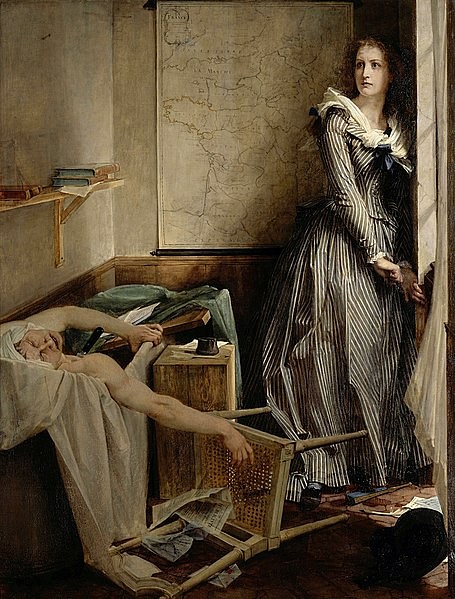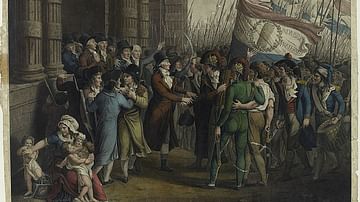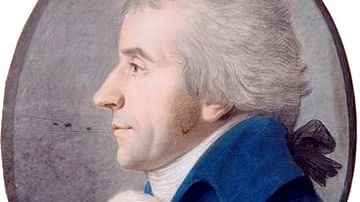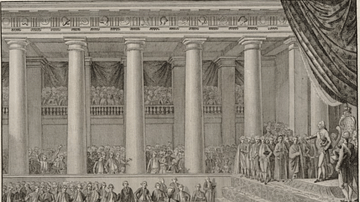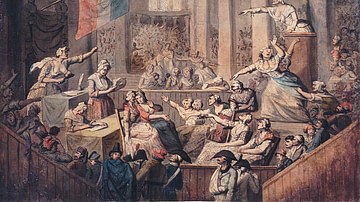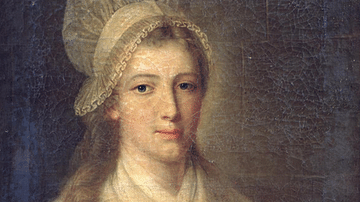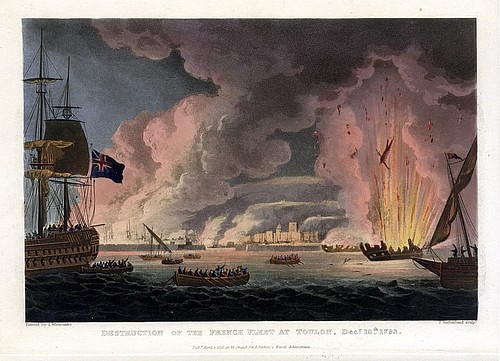
The federalist revolts were a series of rebellions that erupted in several parts of France in the summer of 1793, in response to the concentration of power in Paris during the French Revolution (1789-99). Most of the revolts were crushed within months, leading the victorious Jacobins to implement the Reign of Terror to punish the rebels and enforce their ideology.
The federalist movement began with the moderate Girondin political faction, which advocated for power to be distributed equally amongst France's 83 departments, or provinces. This idea was opposed by the Jacobins, who equated it to federalism, which referred to a decentralization of powers that the Jacobins believed would result in the fragmentation and dissolution of the French Republic. Tensions mounted until 2 June, when an insurrection by Paris mobs resulted in the fall of the Girondins. This was the catalyst for rebellion in several major cities such as Caen, Lyon, Marseille, Toulon, and Bordeaux.
Not every federalist revolt was explicitly pro-Girondin, though they can all be characterized by their anti-Jacobin goals. As this movement was largely still a republican one, the federalist revolts are distinct from the concurrent War in the Vendée, another rebellion that had Catholic and royalist goals. Although the federalist revolts each found initial success in casting off their Jacobin administrations, a lack of coordination with one another led to a rapid loss in momentum. By October, most of the revolts had been crushed, and the federalist rebels were subjected to brutal punitive measures by the Jacobins. On 31 October, the 22 imprisoned Girondins were executed in Paris, while many of those who had fled were killed or committed suicide the following year.
The Question of Federalism
By early 1793, the French Revolution was at a point of crisis. With the days of sweeping societal reforms and ecstatic fraternalism long in the past, the Revolution was now characterized by warfare, paranoia, and factionalism. While the revolutionaries themselves never would have admitted to being partisan (the idea of political parties went against the core principles of the new French Republic), in truth French politics had become a bitter tug-of-war between two main factions: the Mountain, the extremist group closely associated with the Jacobin Club of Paris, and the Girondins, a comparatively moderate faction whose powerbase lay mainly outside of Paris, in the other French departments.
The Girondins had split from the Jacobins over issues such as the conduct of the ongoing French Revolutionary Wars (1792-1802) as well as the trial and execution of Louis XVI in January 1793. But as winter thawed into spring, the major point of contention was the centralization of power in Paris at the expense of the other 82 French departments. The Girondins were concerned that too much of France's destiny was being decided by unruly Paris mobs, which often imposed their will through insurrection and violence. Mobs of Parisian sans-culottes, or revolutionary lower classes, were at the center of the Storming of the Tuileries Palace, which had led to the overthrow of the monarchy, and the September Massacres, which saw the extra-judicial killings of over a thousand 'counter-revolutionaries'. These mobs were often supported and even encouraged by the Mountain and the Paris Commune, or city government. On some occasions, the influence of the Commune eclipsed that of the National Convention which increasingly found itself at the mercy of Parisian crowds.
For the Girondins, therefore, it was necessary to diminish Paris' disproportionate influence in national affairs, lest the voices of millions of provincial citizens be drowned out. It became their mission to reduce Paris to a "1/83 share of influence in France just like all the other departments" (Davidson, 166). A proposal was made to establish a 'departmental guard' recruited from outside Paris to protect the National Convention from the excesses of Parisian anarchy. Another plan called for the seat of government to be removed from Paris altogether and transferred to Bourges in central France, where the Revolution could have a second chance at achieving true national representation.
Such measures were virulently opposed by the Mountain, which accused their Girondin rivals of plotting 'federalism'. In a French revolutionary context, federalism referred to a decentralization of power, equally dispersed amongst the 83 French departments. Many revolutionaries viewed this as problematic, equating it to shattering a unified French state into 83 quasi-independent republics. Each would have its own agenda, and the stronger provinces would inevitably oppress the weaker ones. For the Jacobins, federalism would mean a kind of 'republican feudalism' at its best; at its worst, it was akin to the complete secession of the provinces and the end of the Republic. Jacobin leader Georges Danton called for the deaths of those who wished to carve up France, while Maximilien Robespierre emphasized the need for a unified and indivisible nation.
By mid-1793, the term 'federalist' had become as derogatory a slur as 'monarchist' or 'aristocrat' within the Jacobin lexicon. The Girondins were accused of treasonous or counter-revolutionary intentions, and in mid-April, the revolutionary sections of Paris began to call for the purge of Girondin politicians from the Convention. At the same time, the Girondins accused the Mountaineers of aspiring to dictatorship through their dominance in Paris; in May, anti-Jacobin protests erupted in the cities of Bordeaux, Marseille, and Lyon, leading to the storming of local Jacobin clubs and the arrests of their members. On 23 May, citizens of Dijon told the Convention that, "if it continued to warn against the federalist wolf, it would ultimately cause such a beast to appear" (Furet, 59).
On 2 June, 80,000 of Paris' sans-culottes, in conjunction with the city's National Guard, besieged the Tuileries Palace, calling for the arrest of Girondin leaders. The Mountain obliged, and by nightfall 29 prominent Girondins had been placed under arrest. This caused an exodus of proscribed Girondins from the city, who escaped into the provinces to rail against the Jacobin coup and urge all true patriots to rebellion. By July, the cities of Bordeaux, Marseille, Lyon, Toulon, and Caen heeded the call and openly defied the authority of what was now a firmly Jacobin republic.
Revolt in Normandy & Brittany
In the weeks that followed the fall of the Girondins on 2 June, cities began rising in rebellion. In the north, various Breton and Norman departments rallied around the anti-Jacobin cause, culminating in the arrests of two representatives-on-mission and the declaration by the city of Caen, Normandy, that it was in a state of insurrection on 9 June. This attracted many proscribed Girondin leaders including Marguerite-Élie Guadet, François Buzot, Jérôme Pétion, and Charles Barbaroux, who hoped to use Caen as a base from which to launch a Girondin rebellion. The local military commander, General Felix de Wimpffen, was given command of the northern federalist army, which consisted of men from Brittany and Normandy. Although this army only numbered 3,000 men by early July, Wimpffen clearly expected it to grow; when recalled to Paris by the National Convention to explain his rebellious conduct, Wimpffen defiantly replied that he would indeed return to Paris, but only with 60,000 armed men at his back.
The Girondins hoped to inspire more men to join the cause with the fiery rhetoric for which they had become so famous. While they were able to inspire the young Charlotte Corday to commit the assassination of Marat on 13 July, they were unable to stir up similar anti-Jacobin sentiment in enough of the north's able-bodied fighting men. Moreover, while the Girondins had been treated as heroes upon their arrival in Caen, they were treated with far less warmth by early July, as the royalist-inclined population realized they would not abandon their republican views. So, when General Wimpffen set out for Paris on 8 July, he commanded only about 2,000 men.
Still, hope was not lost. The Girondins believed they could make common cause with the other federalist revolts that had broken out, and maybe even with the Vendean rebels, to coordinate a multi-pronged assault on Paris. Any hope of this happening, however, was dashed on 13 July at the 'battle' of Brécourt. Here, the federalist army was surprised by a small force that the Convention had sent against them. At the first sound of gunfire, the federalists panicked and ran, and the war was over before a battle could ever be fought. The Girondin leaders scattered as the Jacobin forces descended on Caen, many of them taking ship for Bordeaux. Although the now infamous assassin Corday had come from Caen, the region was treated with leniency by the Convention, once the two representatives-on-mission were released. Yet the pacification of Brittany would not last long, as another revolt, known as the Chouannerie, broke out there in 1794.
Revolt in Lyon
The revolt of Lyon would not end so bloodlessly. Boasting a population of over 120,000, Lyon was France's second city, having made its riches largely through the production of silk. However, the mass emigration of aristocrats since the start of the Revolution had dramatically decreased demand for silk, causing many of Lyon's factories to shut down. By 1793, an estimated 50% of its workforce was unemployed, and poverty was rampant.
This dire situation helped bring the local Jacobins to power early that year, particularly the populist revolutionary leader Joseph Chalier. Pledging to help the wage-earning class and lower unemployment rates, Chalier began attacking local bourgeois leaders, threatening to guillotine any silk merchant who cited the recent depression as a reason for not employing more workers. It seemed that the inflammatory rhetoric that served the Jacobins so well in Paris would not work in Lyon, however; on 29 May, the city's industrial and merchant bourgeoisie rose up, seizing the city government, and imprisoning the Jacobin leadership. Chalier himself was executed.
Unlike the weak uprising in the north, Lyon represented a true threat. It had over 10,000 federalist soldiers with which to defend the city, under the command of an aristocrat, Comte de Précy. The Republican Army of the Alps, led by General François-Christophe Kellermann, hero of the Battle of Valmy, was sent to neutralize this federalist threat. The city was besieged on 7 August, and the Jacobin army began shelling it on 22 August, a consistent bombardment that would not cease until the weary defenders surrendered on 9 October.
After the Siege of Lyon, the punishment of the city was left to Georges Couthon, a member of the Committee of Public Safety who had been sent to oversee Lyon's pacification. At first, Couthon wished to bring Lyon back into the fold as the Republic's second city by re-establishing a Jacobin government and setting up revolutionary tribunals to punish ringleaders. But for his colleagues back in Paris, this was not good enough; an example had to be made. Before long, he received instructions that the city of Lyon was to be completely and utterly destroyed, with only the houses of the poor left untouched. What remained would be renamed the Liberated City, while the rest would become a pile of rubble, on which a column would be raised that would read: "Lyon made war on Liberty. Lyon is no more" (Palmer, 156).

Couthon was uneasy about his new task and asked to be removed from his mission at Lyon. He was replaced with Collot d'Herbois, his colleague on the Committee of Public Safety, and Joseph Fouché, who were much more willing to bring the Jacobins' wrath to the people of Lyon. Between October and December, these two men bestowed the full force of the Terror upon the people of Lyon, presiding over the deaths of close to 2,000 citizens; when the guillotine proved too slow for their purposes, they took to rounding up clusters of prisoners and firing into them point blank with cannons filled with shot. Although the city was not utterly destroyed as instructed, the punishment was still devastating, leaving a lasting mark on Lyonnais citizens.
Revolts in Marseille & Toulon
Marseille rebelled in the wake of the fall of the Girondins, breaking up its local Jacobin clubs and arresting their leaders, who were tried and executed in July. Officially declaring federalist independence from Paris, the Marseillais raised an army from surrounding federalist towns, which seized Avignon on 8 July. Meanwhile, the nearby port city of Toulon was also on the point of rebellion. The headquarters of the French Mediterranean Fleet, Toulon had long been the scene of political struggle between the dominant Jacobins and the resident royalists. Hearing about the success of their neighbors in Marseille, the population rebelled against their Jacobin administration on 12 July, closing the city's Jacobin club and hanging 24 of its members. On 27 August, realizing they could never hold out against a Jacobin army, the residents of Toulon surrendered their city and the fleet stationed there to the British, who sent soldiers into Toulon to occupy it under the command of its new governor-general, Major Charles O'Hara.
The task of quelling these southern rebellions fell to Jean-Baptiste François Carteaux, who reclaimed Avignon on 25 July. The federalists of Marseille reached out to British Admiral Samuel Hood, asking for the same protection afforded to Toulon, but Carteaux arrived in Marseille before the British, taking the city on 25 August. The punishment of Marseille was similar to that of Lyon, albeit on a smaller scale. Its name was changed to Ville-Sans-Nom ("city without a name"), and the Jacobin representatives-on-mission went to work establishing a revolutionary tribunal. 412 prisoners were condemned to death, most of them nobility and bourgeoisie. His task in Marseille complete, Carteaux moved on to Toulon, which he promptly besieged.

The Siege of Toulon lasted from 29 August to 19 December, and the city was finally taken largely thanks to the efforts of a 24-year-old artillery officer named Napoleon Bonaparte. As the city fell, the British fleet evacuated the harbor, taking what French ships they could and burning the rest. Around 7,000 Toulon federalists escaped with the British. When the Jacobins took control of the city, they shot and bayoneted around 700 of the federalists who had remained in the city's Champ de Mars. Bonaparte, who was being treated for his wounds, did not participate in the massacre. Yet he was undeniably the star of the siege and was afterwards promoted to brigadier-general, beginning his illustrious career.
Revolt in Bordeaux
Bordeaux was notable for being the revolt that stood most firmly behind the Girondin cause. As the home of many of the leading Girondins, it never had the issue of divided loyalties which hindered the other federalist revolts, and the city had risen up in support of the Girondins in May, before their arrests on 2 June. On 7 June, the department of the Gironde declared itself in a state of insurrection and attempted to raise an army. Yet despite massive support for the federalist cause, the Girondins had little luck recruiting soldiers; only 400 men ended up enlisting.
This lack of military strength ended the Bordeaux insurrection almost as quickly as it had begun. The Convention persuaded neighboring departments to isolate the Gironde, by refusing to sell it food or other supplies. In October, Republican soldiers entered the city, establishing a pro-Jacobin provisional government and a revolutionary tribunal to try the traitors. Bordeaux ended up being spared a mass slaughter; out of 834 verdicts, only 104 executions ended up taking place between October 1793 and July 1794.
Yet the Girondin leaders who had escaped from Caen would not be spared. In June 1794, a month before the end of the Terror, most of them were discovered in their hiding places in the Gironde. Pétion and Buzot killed themselves on 18 June rather than face the guillotine. Their bodies were discovered a week later, half-eaten by wolves. Barbaroux was captured after a botched suicide attempt and was taken to Bordeaux, where he was executed alongside Guadet. Marquis de Condorcet, the famous Enlightenment mathematician who had written the Girondin constitution, was found dead in his prison cell, likely by suicide. Their deaths marked the last vestiges of the Girondist and federalist revolts from the year before.
Aftermath
The federalist revolts, which had broken out in May and June 1793, were mostly over by October. The Jacobins, now fully secure in their power, imposed the Reign of Terror to enforce their ideology, punish federalist rebels, and root out other counter-revolutionary traitors. Some of the first victims of the Terror were supposed federalists, as seen in places like Lyon and Marseille where executions were vigorously carried out. In Paris itself, some of the Terror's first victims were the 22 Girondin leaders who had been captured after their initial purge, such as Jacques-Pierre Brissot, and Pierre Vergniaud. After a sham trial, they were taken in a tumbril to the guillotine on 31 October, defiantly singing La Marseillaise as they went. One by one they were executed until their singing was extinguished. A week later, the famous female Girondin Madame Roland went to the guillotine; her last words were, "Liberty! What crimes are committed in your name" (Scurr, 290).
With their deaths, and the executions and suicides of their surviving colleagues the next year, the Girondins were extinguished, and the federalist revolts were at an end. The Committee of Public Safety, dominated by Maximilien Robespierre and his allies from the Mountain, reigned over France, overseeing the bloodshed that would continue until the Thermidorian Reaction in July 1794.


